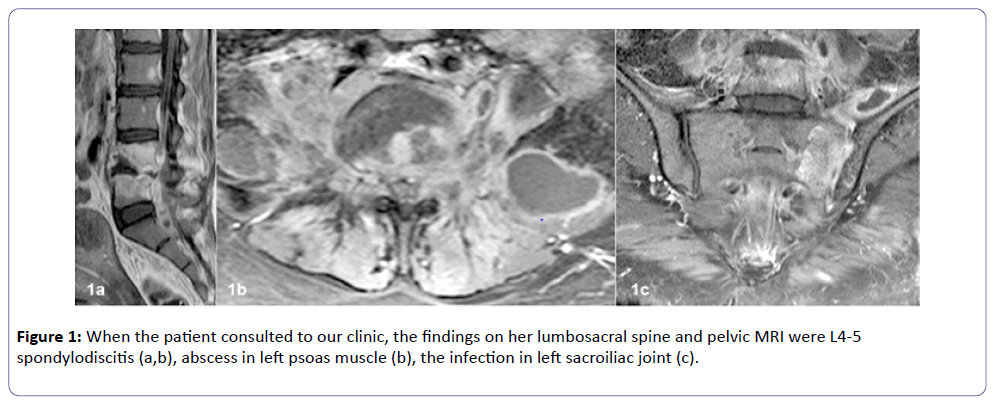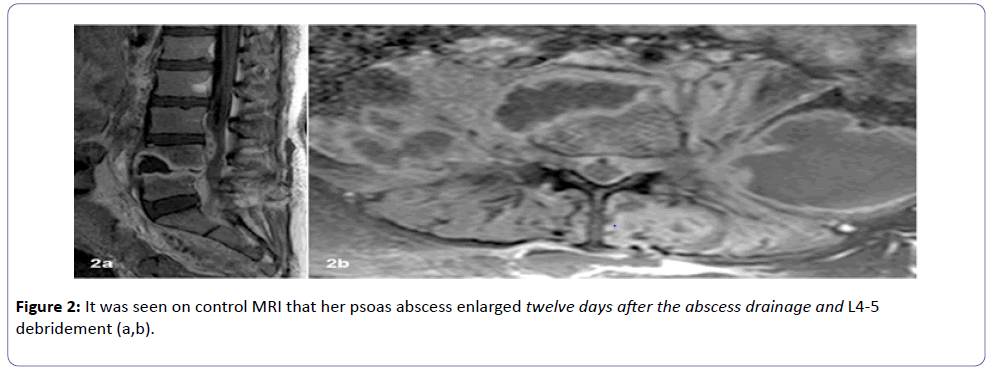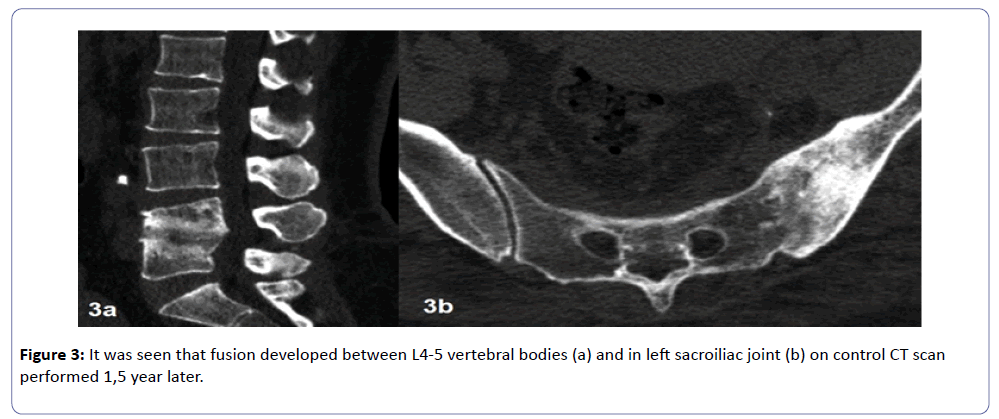Lumbar Tuberculous Spondylodiscitis, Sacroiliitis and Paraspinal Abscess with Staphylococcus Aureus Superinfection
Burak Eren*, Feyza Karagoz Guzey, Ozgur Yusuf Aktas, Ilker Gulec, Nuri Serdar Bas, Murat Karacan and Cafer Korkut
DOI10.4172/2471-8416.100057
Burak Eren*, Feyza Karagoz Guzey, Ozgur Yusuf Aktas, Ilker Gulec, Nuri Serdar Bas, Murat Karacan and Cafer Korkut
Department of Neurosurgery, Health Sciences University, Bagcilar Training and Research Hospital, Istanbul, Turkey
- *Corresponding Author:
- Burak Eren, MD
Department of Neurosurgery, BaÃÆââ¬Å¾Ãâà ¸cÃÆââ¬Å¾Ãâñlar Training and Research Hospital
Merkez Mah. Mimar Sinan Cad. 6. Sok, Istanbul, Turkey
Tel: 718-283-8805
Fax: 902124404242
E-mail: drburakeren@hotmail.com
Received date: May 10, 2018; Accepted date: May 21, 2018; Published date: May 25, 2018
Citation: Eren B, Guzey FK, Aktas OY, Gulec I, Bas NS, et al. (2018) Lumbar tuberculous spondylodiscitis, sacroiliitis and paraspinal abscess with Staphylococcus aureus superinfection. J Clin Exp Orthop Vol 4:57. DOI: 10.4172/2471-8416.100057
Copyright: © 2018 Eren B, et al. This is an open-access article distributed under the terms of the Creative Commons Attribution License, which permits unrestricted use, distribution, and reproduction in any medium, provided the original author and source are credited.
Abstract
Spine is the most common skeletal part in which tuberculosis locates. It has been published in a few cases that nonspecific agents might be cultured from joint or spine involvement with tuberculosis. We report a case in which spine and sacroiliac joint infection developed while receiving treatment for pulmonary tuberculosis and treated with abscess drainage, antibiotherapy and hyperbaric oxygen therapy was reported. It should be kept in mind that in spine and major joint infections which develop in the cases with a tuberculosis history, there might be nonspecific microorganisms as well. In the infections that result in deterioration of the patient’s general condition, applying antibiotherapy along with hyperbaric oxygen therapy might accelerate the response to the treatment.
Keywords
Spinal infection; Hyperbaric oxygen therapy; Sacroiliitis; Staphylococcus aureus; Tuberculosis; Superinfection
Introduction
Tuberculosis is still a serious health problem in developing countries, and it has been increased in developed countries during the past two decades [1]. The most common skeletal part in which tuberculosis locates is spine [2]. Sacroiliac joint involvement is rarer than vertebral involvement and it constitutes about 3-9, 7% of all musculoskeletal system involvement [3]. Sacroiliac joint tuberculosis has occasionally been reported with lumbar spine [4].
It has been published that nonspecific agents may be cultured from joint or spine involvement with tuberculosis in a few cases in literature [5-7]. Also, it is known that hyperbaric oxygen therapy (HBO) may accelerate recovery of severe cases of spine and major joint involvement with both tuberculosis and nonspecific agents [8-9].
In this report, a case in which spine and sacroiliac joint infection developed while receiving treatment for pulmonary tuberculosis and treated with abscess drainage, antibiotherapy and HBO.
Case Report
A 44 year-old woman with diabetes mellitus was transferred to our clinic from another center. We were informed that she had left hip and back pain while she was treated for pulmonary tuberculosis for two months. L4-5 spondylodiscitis, left side psoas abscess and sacroiliitis were diagnosed and her psoas abscess was drained. There was no reproduction in the culture of the material drained, antituberculosis treatment had been continued as her spine and joint involvements had been related to tuberculosis because she already had tuberculosis history.
Two months after the abscess was drained, as weakness in her feet and deterioration in her general condition emerged and left hip and back pain were intensified the patient was directed to our clinic. In her medical examination, tenderness in her waist and left hip was diagnosed. In her neurological examination, there were left side tibialis anterior and extensor hallucis longus paresis with 2/5 muscle strength and left L4, L5 and S1 hypoesthesia. Sphincter control was normal.
Erythrocyte sedimentation rate (ESR) was 140 mm/h, Creactive protein (CRP) was 200 mg/L and white blood cell (WBC) count was 20120/mm3. On magnetic resonance imaging (MRI) of lumbosacral spine and pelvis, the findings were spondylodiscitis, epidural and paravertebral abscess in L4-5 disc level, the infection in left sacroiliac joint and a huge abscess in left psoas muscle (Figure 1).
She operated on and L4-5 debridement and decompression were performed with posterior approach and also left psoas abscess was percutaneously drained. Staphylococcus aureus was isolated in the culture. Acid resistant bacillus was not detected on direct staining and gram positive cocci were seen. On pathological examination, it was reported that acute infection symptoms were diagnosed and chronic granulomatous symptoms were not observed. Even though the appropriate antibiotherapy was applied, it was observed that the patient had deterioration in her general condition and her psoas abscess enlarged according to the radiological finding (Figure 2).
Twelve days after the first drainage, percutaneous drainage of left psoas abscess was performed again and 30 sessions of HBO along with antibiotherapy were applied. Staphylococcus aureus isolated in the culture again. The patient whose general condition improved was stood up with help of a lumbosacral orthosis. In her radiological examinations, it was observed that the huge psoas abscess disappeared, sacroiliitis and spondylodiscitis healed reasonably. ESR was 11 mm/h, CRP was 8, 1 mg/L, WBC was 8490/ mm3. There was still no reproduction in the tuberculosis culture. The patient was discharged 1, 5 months after she was hospitalized and she was recommended to continue the antituberculosis treatment and oral treatment for nonspecific infection.
After 1, 5 years of her discharge, she had not any complaint and there was not any neurological deficit on her examination. She could mobilize without any support. On her control computerized tomography (CT), it was seen that fusion developed vertebral bodies and sacroiliac joint (Figure 3).
Discussion
It was reported that both tuberculosis bacillus and non specific agents may be responsible for the spine and major joint infections which develop in the cases with tuberculosis history [1,5-7]. Klein and McConville reported a case with a concomitant pneumococcal and tuberculosis arthritis of knee. That is the first reported case of concomitant pyogenic arthritis and osteoarticular tuberculosis [5]. Then, Opara et al. reported a case with tuberculosis arthritis of the knee with staphylococcus superinfection [1]. In those cases, there was no history of tuberculosis, and tuberculous and septic arthritis were diagnosed concomitantly. In our case, bacteria could not be isolated in the first specimen that had been taken from psoas abscess and as the patient already had active pulmonary tuberculosis, her antituberculosis treatment had been continued assuming that her spine and sacroiliac joint involvement had been related to tuberculosis. This situation caused her spine and joint infections to be untreated and get worse. Thus, it is recommended that the diagnosis is confirmed microbiologically and pathologically in as all cases as possible.
Applying antibiotherapy along with HBO on the serious infections in the patients with deterioration of general condition may accelerate the response to the treatment. Fu et al. reported a middle aged woman with concomitant tuberculous and pyogenic spondylodiscitis of the cervical spine [7]. Anterior decompression and fusion were performed, followed by therapy with antituberculous drugs and nonspecific antibiotics. The patient completely recovered. They recommended to perform radical debridement all of the infection foci in these cases. However in our patient, a limited debridement and drainage of large abscess with HBO could provide a good clinical result. Topuz et al. stated that in tuberculous spondylodiscitis cases with serious spine involvement, applying antituberculosis treatment with HBO rather than only antituberculosis treatment provides earlier clinical and radiological recovery [8]. There are also some studies which state the efficiency of HBO in septic arthritis [9].
Tuberculous sacriliitis may also be a disabled condition. Sometimes it may associate to lower lumbar vertebral involvement as to be in our case. Natural history of sacroiliac tuberculosis is bony ankylosis [4,10]. Ramlakan et al. reported 15 cases with tuberculous sacroiliitis and two of them have concomitant lumbar spondylodiscitis [4]. Biopsy and curettage was performed in all patients and the sacroiliac joint fused spontaneously within 2 years in that series. Similarly, fusion in vertebra and sacroiliac joint was observed within 1, 5 years in our case.
Limitations of this study; the cause of pyogenic infection may be due to contamination during abscess drainage, and the effect of the hyper baric oxygen cannot be effectively analysed based on one case.
Conclusion
It should be kept in mind that in spine and major joint infections which develop in the cases with a tuberculosis history, the responsible agent is not always tuberculosis bacillus, and there may be nonspecific microorganisms also. The diagnosis should be confirmed microbiologically and pathologically. Applying antibiotherapy along with HBO in the infections that cause deterioration of the patient’s general condition may accelerate the response to the treatment.
References
- Opara TN, Gupte CM, Liyanage SH, Poole S, Beverly MC (2007) Tuberculous arthritis of the knee with Staphylococcus superinfection. J Bone Joint Surg Br 89: 664-666.
- Silva JF (1980) A review of patients with skeletal tuberculosis treated at the University Hospital, Kuala Lumpur. Int Orthop 4: 79-81.
- Papagelopoulos PJ, Papadopoulos EC, Mavrogeniz AF, Themstocleous GS, Korres DS, et al. (2005) Tuberculous sacroiliitis. A case report and review of the literature. Eur Spine J 14: 683-688.
- Ramlakan RJS, Govender S (2007) Sacroiliac joint tuberculosis. Int Orthop 31: 121-124.
- Klein MD, McConville JH (1989) Simulaneous pneumococcal arthritis and osteoarticular tuberculosis. South Med J 82: 664-665.
- Shin JH, Sung SI, Kim JK, Jung JM, Kim ES, et al. (2013) Retropharyngeal abscess coinfected with Staphylococcus aureus and Mycobacterium tuberculosis after rhinoviral infection in a 1-monthold infant. Korean J Pediatr 56: 86-89.
- Fu WK, Wu WC, Ip FK (1998) Concomitant tuberculosis and pyogenic infection of the cervical spine. A case report. Spine (Phila Pa 1976) 23: 139-143.
- Topuz K, Kutlay AM, Simşek H, Colak A, Kaya S, et al. (2009) Effect of hyperbaric oxygen therapy on the duration of treatment of spinal tuberculosis. J Clin Neurosci 16: 1572-1577.
- Merle-Melet M, Mainard D, Regent D, Dopff C, Tamisier JN, et al. (1994) An unusual case of hip septic arthritis due to Bacteroides fragilis in an alcoholic patient. Infection 22: 353-355.
- Avcu S, Mentes O, Bulut MD, Sunnetcioglu M, Karahocagil MK (2010) Sacroiliitis due to Salmonella Typhi: A case report. N Am J Med Sci 2: 208-210.
Open Access Journals
- Aquaculture & Veterinary Science
- Chemistry & Chemical Sciences
- Clinical Sciences
- Engineering
- General Science
- Genetics & Molecular Biology
- Health Care & Nursing
- Immunology & Microbiology
- Materials Science
- Mathematics & Physics
- Medical Sciences
- Neurology & Psychiatry
- Oncology & Cancer Science
- Pharmaceutical Sciences



